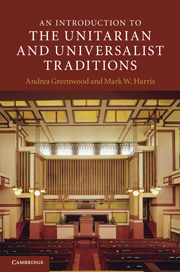Book contents
- Frontmatter
- Contents
- Acknowledgements
- A note on names
- Chapter 1 Introduction
- Chapter 2 Beginnings
- Chapter 3 Great Britain
- Chapter 4 From revelation to reason
- Chapter 5 From reason to intuition to freedom
- Chapter 6 A religion for one world
- Chapter 7 Congregational polity
- Chapter 8 Worship
- Chapter 9 Sources of faith
- Chapter 10 Science and ecology
- Chapter 11 Architecture, art, and music
- Chapter 12 Education and social justice
- Chapter 13 Current issues, new directions
- Selected bibliography
- Index
- References
Chapter 13 - Current issues, new directions
Published online by Cambridge University Press: 05 June 2012
- Frontmatter
- Contents
- Acknowledgements
- A note on names
- Chapter 1 Introduction
- Chapter 2 Beginnings
- Chapter 3 Great Britain
- Chapter 4 From revelation to reason
- Chapter 5 From reason to intuition to freedom
- Chapter 6 A religion for one world
- Chapter 7 Congregational polity
- Chapter 8 Worship
- Chapter 9 Sources of faith
- Chapter 10 Science and ecology
- Chapter 11 Architecture, art, and music
- Chapter 12 Education and social justice
- Chapter 13 Current issues, new directions
- Selected bibliography
- Index
- References
Summary
Unitarians and Unitarian Universalists worldwide are connected to one another, and identify with this faith, even in its various regional incarnations. This has always been the case. The burgeoning liberal movement in Eastern Europe did not appear spontaneously. The radicals read and were persuaded by Servetus, absorbed humanism, and were protected by Muslims. In Great Britain, Dissenters read and re-read continental Unitarian literature while the Church of the Strangers embraced outsiders. Even in America, where generations of students learned that Unitarianism was mostly indigenous, it is now known that the Socinianism of those earliest European heretics seeped in, despite the New Englanders’ attempts to fend it off. The spirit of freedom from abroad infused those who expanded Unitarianism into the West, building new congregations. Today, the international movement seeks new avenues of expansion, and new areas of growth that may help sustain the faith in its ancient strongholds. Technology fosters bonds by making outreach, support, and connection easier. The process of sharing with one another globally also reifies the faith itself, by acting on the religious imperative to grow and learn from one another.
- Type
- Chapter
- Information
- An Introduction to the Unitarian and Universalist Traditions , pp. 235 - 243Publisher: Cambridge University PressPrint publication year: 2011



